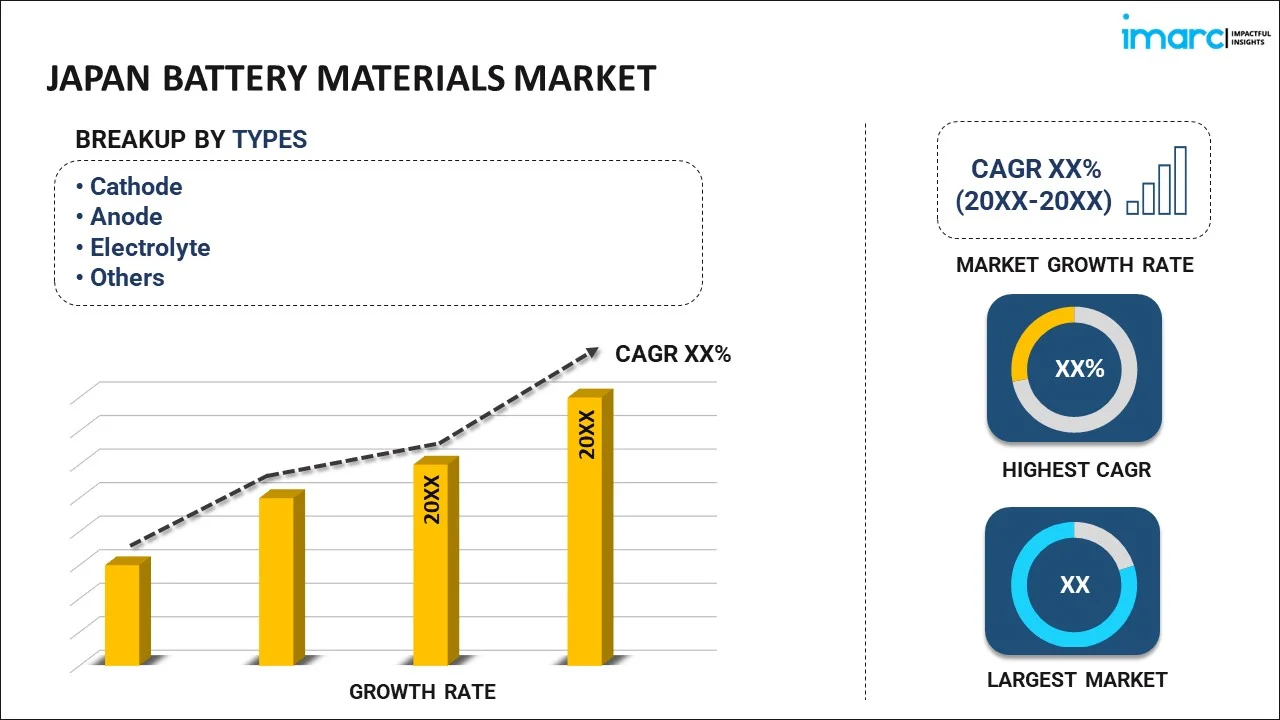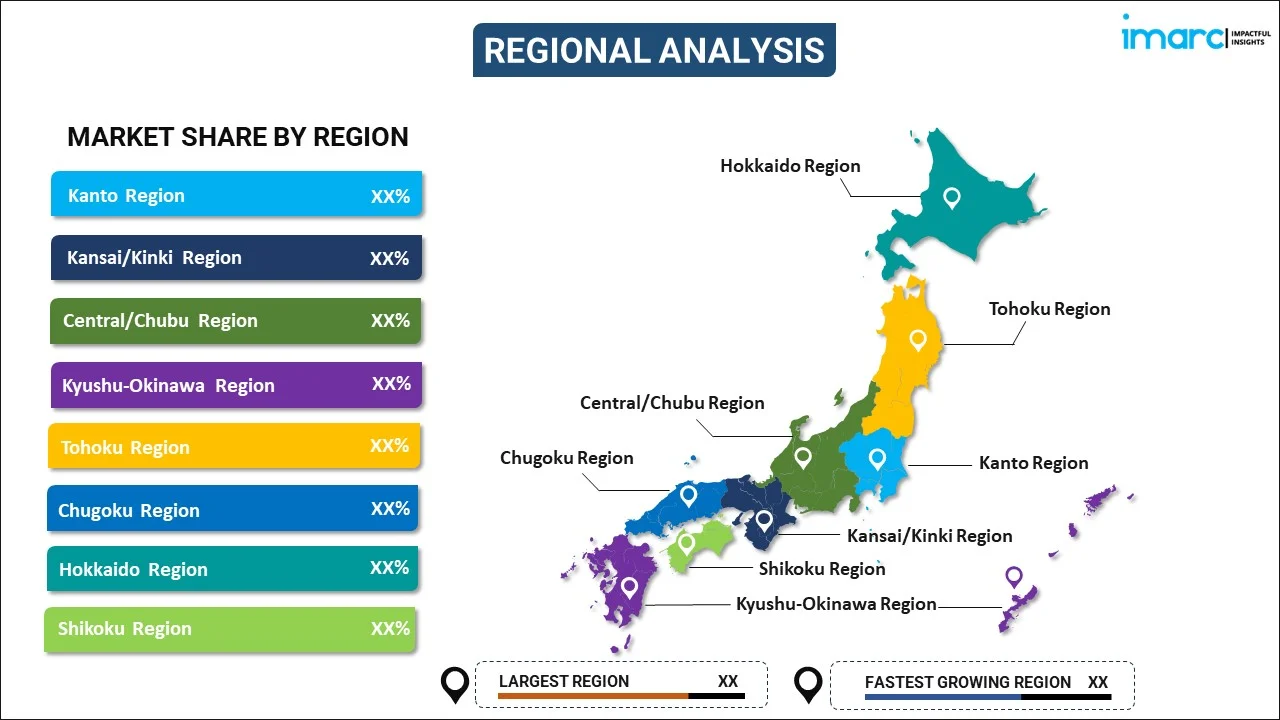
Japan Battery Materials Market Report by Type (Cathode, Anode, Electrolyte, Separator, and Others), Battery Type (Lithium Ion, Lead Acid, and Others), Application (Automobile Industry, Household Appliances, Electronics Industry, and Others), and Region 2025-2033
Market Overview:
Japan battery materials market size reached USD 3,341 Million in 2024. Looking forward, IMARC Group expects the market to reach USD 5,183 Million by 2033, exhibiting a growth rate (CAGR) of 5% during 2025-2033. The rise in electric vehicles (EVs), increasing government support for renewable energy, advanced materials research, eco-friendly regulations, increased energy storage demand, consumer electronics innovation, disaster preparedness, and expanding medical device requirements, represent some of the key factors driving the market.
|
Report Attribute
|
Key Statistics
|
|---|---|
|
Base Year
|
2024 |
|
Forecast Years
|
2025-2033 |
|
Historical Years
|
2019-2024
|
| Market Size in 2024 | USD 3,341 Million |
| Market Forecast in 2033 | USD 5,183 Million |
| Market Growth Rate (2025-2033) | 5% |
Battery materials are a class of specialized substances crucial to the construction and performance of various types of batteries, which are essential components in modern electronics and energy storage systems. These materials are meticulously designed to store and release electrical energy efficiently. One of the most common types of battery materials is the electrodes, which include an anode (typically made of materials like graphite, lithium, or silicon) and a cathode (commonly featuring materials like lithium cobalt oxide or nickel manganese cobalt). The electrolyte, another fundamental component, is usually a lithium salt dissolved in a solvent, facilitating the flow of ions between the electrodes during charge and discharge cycles. Additionally, separators, often made of porous polymers, prevent physical contact between the anode and cathode while allowing the passage of ions. Battery materials also encompass various additives and coatings to enhance performance, safety, and longevity, such as conductive agents, binders, and protective layers.
Japan Battery Materials Market Trends:
Japan's commitment to environmental sustainability has catalyzed the expansion of the electric vehicle (EV) market, necessitating advanced battery materials with improved energy density and longevity, which is primarily driving the market growth. Besides this, the country's extensive expertise in materials science and engineering has led to significant innovations in electrode materials, electrolytes, and separators, enhancing battery performance and efficiency thereby bolstering the market growth. Moreover, stringent government regulations and a heightened awareness of environmental concerns have propelled a shift toward green energy storage solutions, such as eco-friendly and recyclable battery materials, creating a favorable outlook for market expansion. In confluence with this, the global push for renewable energy sources has further fueled the demand for energy storage systems, boosting the market for advanced battery materials that can store and release energy efficiently. Concurrently, the flourishing expansion of the consumer electronics sector, driven by innovation and increasing demand for longer-lasting batteries, has spurred investments in cutting-edge battery materials, strengthening the market growth. In addition to this, Japan's focus on disaster preparedness has led to a growing market for energy storage in residential and industrial sectors, necessitating reliable and high-performance battery materials, thereby contributing to the market growth. Furthermore, the aging population and the surging need for medical devices, along with extensive collaborations between academia, industry, and government agencies, have driven research and development (R&D) into miniature and long-lasting battery materials for healthcare applications, impelling the market growth. Apart from this, the thriving space industry in Japan is acting as another significant growth-inducing factor, with a need for robust and lightweight battery materials for satellites and space exploration.
Japan Battery Materials Market Segmentation:
IMARC Group provides an analysis of the key trends in each segment of the market, along with forecasts at the country level for 2025-2033. Our report has categorized the market based on type, battery type, and application.
Type Insights:

- Cathode
- Anode
- Electrolyte
- Separator
- Others
The report has provided a detailed breakup and analysis of the market based on the type. This cathode, anode, electrolyte, separator, and others.
Battery Type Insights:
- Lithium Ion
- Lead Acid
- Others
A detailed breakup and analysis of the market based on the battery type have also been provided in the report. This includes lithium ion, lead acid, and others.
Application Insights:
- Automobile Industry
- Household Appliances
- Electronics Industry
- Others
The report has provided a detailed breakup and analysis of the market based on the application. This includes automobile industry, household appliances, electronics industry, and others.
Regional Insights:

- Kanto Region
- Kansai/Kinki Region
- Central/ Chubu Region
- Kyushu-Okinawa Region
- Tohoku Region
- Chugoku Region
- Hokkaido Region
- Shikoku Region
The report has also provided a comprehensive analysis of all the major regional markets, which include Kanto Region, Kansai/Kinki Region, Central/ Chubu Region, Kyushu-Okinawa Region, Tohoku Region, Chugoku Region, Hokkaido Region, and Shikoku Region.
Competitive Landscape:
The market research report has also provided a comprehensive analysis of the competitive landscape. Competitive analysis such as market structure, key player positioning, top winning strategies, competitive dashboard, and company evaluation quadrant has been covered in the report. Also, detailed profiles of all major companies have been provided.
Japan Battery Materials Market Report Coverage:
| Report Features | Details |
|---|---|
| Base Year of the Analysis | 2024 |
| Historical Period | 2019-2024 |
| Forecast Period | 2025-2033 |
| Units | Million USD |
| Scope of the Report | Exploration of Historical Trends and Market Outlook, Industry Catalysts and Challenges, Segment-Wise Historical and Future Market Assessment:
|
| Types Covered | Cathode, Anode, Electrolyte, Separator, Others |
| Battery Types Covered | Lithium Ion, Lead Acid, Others |
| Applications Covered | Automobile Industry, Household Appliances, Electronics Industry, Others |
| Regions Covered | Kanto Region, Kansai/Kinki Region, Central/ Chubu Region, Kyushu-Okinawa Region, Tohoku Region, Chugoku Region, Hokkaido Region, Shikoku Region |
| Customization Scope | 10% Free Customization |
| Post-Sale Analyst Support | 10-12 Weeks |
| Delivery Format | PDF and Excel through Email (We can also provide the editable version of the report in PPT/Word format on special request) |
Key Questions Answered in This Report:
- How has the Japan battery materials market performed so far and how will it perform in the coming years?
- What has been the impact of COVID-19 on the Japan battery materials market?
- What is the breakup of the Japan battery materials market on the basis of type?
- What is the breakup of the Japan battery materials market on the basis of battery type?
- What is the breakup of the Japan battery materials market on the basis of application?
- What are the various stages in the value chain of the Japan battery materials market?
- What are the key driving factors and challenges in the Japan battery materials?
- What is the structure of the Japan battery materials market and who are the key players?
- What is the degree of competition in the Japan battery materials market?
Key Benefits for Stakeholders:
- IMARC’s industry report offers a comprehensive quantitative analysis of various market segments, historical and current market trends, market forecasts, and dynamics of the Japan battery materials market from 2019-2033.
- The research report provides the latest information on the market drivers, challenges, and opportunities in the Japan battery materials market.
- Porter's five forces analysis assist stakeholders in assessing the impact of new entrants, competitive rivalry, supplier power, buyer power, and the threat of substitution. It helps stakeholders to analyze the level of competition within the Japan battery materials industry and its attractiveness.
- Competitive landscape allows stakeholders to understand their competitive environment and provides an insight into the current positions of key players in the market.
Need more help?
- Speak to our experienced analysts for insights on the current market scenarios.
- Include additional segments and countries to customize the report as per your requirement.
- Gain an unparalleled competitive advantage in your domain by understanding how to utilize the report and positively impacting your operations and revenue.
- For further assistance, please connect with our analysts.
 Inquire Before Buying
Inquire Before Buying
 Speak to an Analyst
Speak to an Analyst
 Request Brochure
Request Brochure
 Request Customization
Request Customization




.webp)




.webp)












